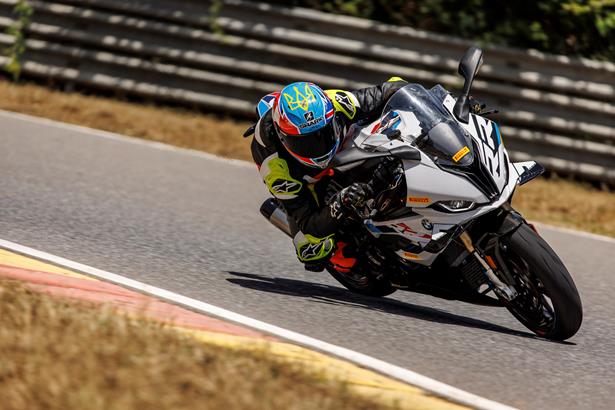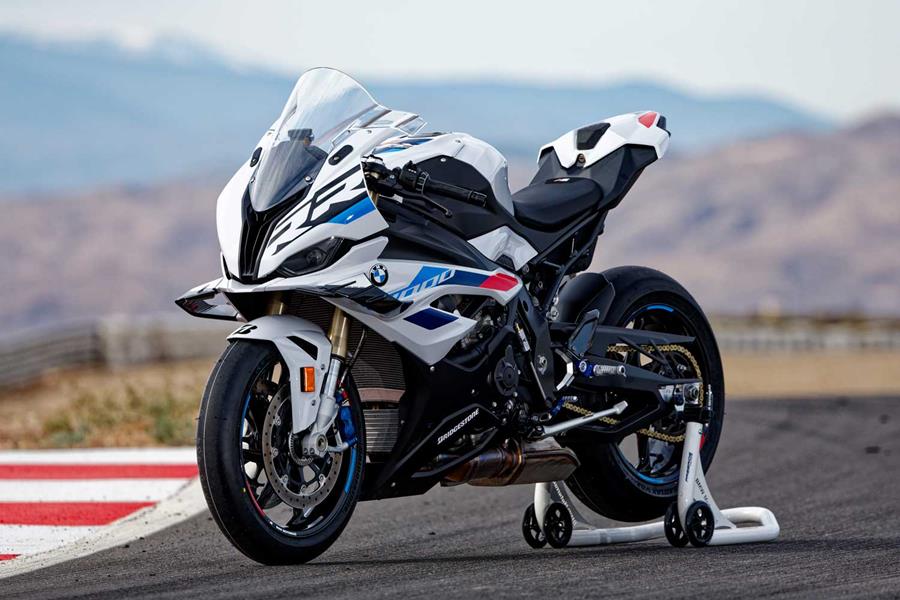
2024-on BMW S1000RR review: this is the easiest and comfiest of all the superbikes to ride fast
The BMW S1000RR is a superbike and the fourth generation of a machine that first arrived on the scene in 2010. At a time when its rivals could barely muster a rear-wheel 160bhp, the German wonder machine made 190bhp, had MotoGP-inspired electronics and race-ready handling - impressive for a company best known for sensible tourers and adventure bikes.
Refined in 2012 and updated in 2015, it’s a multiple TT winner, loved by racers and is the circuit weapon of choice for discerning track heads. Its long-awaited successor has been four years in the making and new from the ground-up.
From its sultry looks and electronic gadgetry, to its fresh new easy feel, the BMW S1000RR is a major departure from the previous model. Only the name remains the same. Agile, accurate and refined, it handles like a lightweight 600cc supersport racer with the grunt of a V4 and the manic top end power of a competition superbike.
A tricky-to-reach back brake and its late arrival in dealers are the only niggles we can find. The old RR was rapid to the end, but with a decade’s worth of lessons learned from it, this latest BMW S1000RR takes the superbike game to the next level.

What's new for 2024?
BMW’s latest S1000RR superbike is tricker and more powerful than all its previous iterations. And yet through a host of performance, electronic, aerodynamic and chassis updates it’s also easier to ride than its older incarnations and main rivals.
Producing a massive 210bhp and 83.3lb.ft (up 3bhp on the previous model), BMW has concentrated its efforts for 2024 making the S1000RR friendlier and more efficient to use, both on road and track. Key updates include:
- Sleeker aerodynamics with a redesigned front end and a taller screen to reduce wind-induced helmet vibration, improve cruising comfort and provide a slipperier profile at speed on track.
- New composite winglets generate downforce on track of 17.1 kg at 300kph, counteracting the bike’s tendency to wheelie under hard acceleration - also lessening the DTC traction control’s effect - and therefore improving drive.
- The new steering angle sensor again assists hard acceleration by measuring drift angle and linking with the 6-stage traction control system to minimise spin and slip, thus allowing maximum drive. The angle sensor also allows the use of two other systems; Brake Slide Assist for deceleration and Slip/Slide Control for acceleration. All accessed through the new Pro riding mode.
- A redesigned cylinder head with reworked valve geometry (borrowed from the M1000RR) helps boost power, torque and throttle response throughout the rev range.
- A one-tooth larger rear sprocket (from 45 to 46) gives more oomph to lowdown drive - especially useful off turns, particularly on track.
- Reworked airbox increases air flow into the engine for more power.
- M-spec chassis geometry with an adjustable swingarm pivot as standard, a raised rear end, reduced steering head angle by 0.5° to 66.4°, and decreasing the offset by 3mm to 26.5mm further aids steering accuracy. Semi-active damping is now alterable through a range of Road, Race and Dynamic modes, maximising performance on both track and street.
- A lighter lithium battery saves 2kg over the previous design.
- The M GPS Laptrigger can record lap times on more than 300 tracks worldwide - brilliant for regular trackday riders.
- The inbuilt SOS system automatically communicates with emergency services in the event of an accident.
- For trackday riders there’s a new M cover kit to reduce case damage in the event of an on-track spill.
- Improved quickshifter now permits up and down shifts on the overrun; the damping mechanism has also been tweaked to improve lever action.
- The new TFT dash features even more useful functions, such as a recommended maximum top speed/rpm until the engine reaches operating temperature; three core displays, plus a ‘Pure Ride’ screen which displays only what’s needed for track or swift riding.
Upgrade Pack Options
- M Pack: includes M-Sport paint, higher M seat unit, M footrests, lightweight carbon wheels (forged wheels also available), and black filler cap. Costs £4740.
- Dynamics pack: ideal for track use; includes DDC electronic chassis, three Pro Riding modes complimented by three additional Race Pro modes, launch control, pit lane limiter, wheelie control, brake slide assist and slide control. There’s also cruise control and heated grips for on road use! S1000RR Sport features the Dynamics pack, plus tyre pressure control. The pack costs £1485.
- Race pack: again, ideal for trackdayers and those wanting to race. Includes lightweight M endurance chain, M titanium Akrapovic exhaust or a titanium slip-on end can. Costs £990.
- Carbon pack: includes full carbon fibre chain guard, front mudguard, rear hugger, and top fairing panels. Costs £2050.
- M Billet pack: includes milled aluminium parts like footrests, levers and lever guards. Costs £435.
2023 BMW S1000RR Updates:

Although the 2019 BMW S1000RR was pretty much bang on, the 2023 model takes another step forward. It has more power, new electronics, including an advanced slide control system, stronger brakes, a flexier chassis with revised geometry and wings.
Its level is way beyond most of us could ever hope to exploit and to even begin to use its electrical wizardry to go fast will take some serious talent.
But thanks to its upgrades it’s not only a brutally quick superbike, but one with an even bigger safety margin on the road and track, especially on worn tyres.
It’s hard to say if it's dynamically better than the old one, but the engine, ride and electronics are all smoother, making it the easiest of all the superbikes to ride fast.
2023 BMW S1000RR on the road:
It should come as no surprise to learn the new RR’s extra power, uprated electronics, chassis changes and aero make little difference at normal speeds. It has a tougher character, though. The new electronic suspension settings are firmer, even in its soft ‘Road’ riding mode and the new brakes have race-grade power and feel with no ABS mush through the lever. And it goes without saying that with 207bhp, there’s never a shortage of power on the road. It’s a rocket ship, pure and simple.
The new RR has the taught feel of a superstock race bike out of the crate and feels sharper on the throttle and in corners than the first generation M1000RR. But despite the huge reserves of straight line and cornering performance available the ’23 S1000RR is as simple to manage on the road as it is on track. Electronics and wings keep the front wheel down under hard acceleration, the up/down quickshifter slices effortlessly through the gears, it’s always stable and knowing there’s has one of the best traction control systems in the business looking after you is a comfort with all that power on tap.
It's quick beyond comprehension, but never aggressive at road speeds. It’s also a BMW, which means it’s a sportsbike you can actually use on the road, even for long trips. The riding position is at the milder end of the race-rep scale, the tall screen cuts more quietly through the wind than an R1250GS and although the seat is on the firm side, it isn’t torturous. Heated grips, cruise control and a large colour dash with superb Bluetooth functions all take the sting out of life with a superbike on the road.
Nothing gets close to the BMW’s ability to be a track demon with such impeccable road manners.
Watch: 2023 BMW S1000RR video review
2021 BMW S1000RR updates:
In July 2020 BMW announced the changes for the 2021 S1000RR range, including a new blacked out paintjob called black storm metallic.
The new, stealthy look features a black subframe and plastics, with the only splash of colour coming from vivid red ‘RR’ decals on the fairing.

The bike will also reach Euro5 homologation for the first time, having technically remained Euro4 until now.
You are also able to spec up your S1000RR with a raft of blingy parts from the M Sport catalogue. The M milled parts package gets you upgraded folding brake and clutch levers and protectors for them plus the footpegs and engine protectors from the M version.
You can also add a sports silencer, or the titanium exhaust from the M and real track enthusiasts can unlock the GPS-controlled Laptrigger function, too.
The new colour will replace racing red non metallic for the base model S1000RR, and Hockenheim silver remains the other base option.
2021 also saw the introduction of a new range-topping homologation special called the BMW M1000RR. The M version has a stronger engine for race teams to tune more reliably and an aero pack. Due to its comparatively basic suspension (race teams chuck it in the bin anyway) the S1000RR is still a better option from most road riders.
2019 BMW S1000RR: was the best superbike around.
Our testers rate the S1000RR so highly that it took the overall win the Best Sportsbike category of the 2020 MCN Awards.
Since then we've seen a raft of new competitors hit the roads, and it's not quite up there with the very best of the bunch in 2023, but it's still a simply stunning superbike.
And if you're looking for something even more special, you could also pop over to the BMW M1000RR review to see if the vastly more expensive homologation special is the better bike for you.
2019 BMW S1000RR video review
Join Neevesy for his thoughts on the S1000RR live from the launch.
Link nội dung: https://pus.edu.vn/moto-bmw-s1000rr-a60702.html